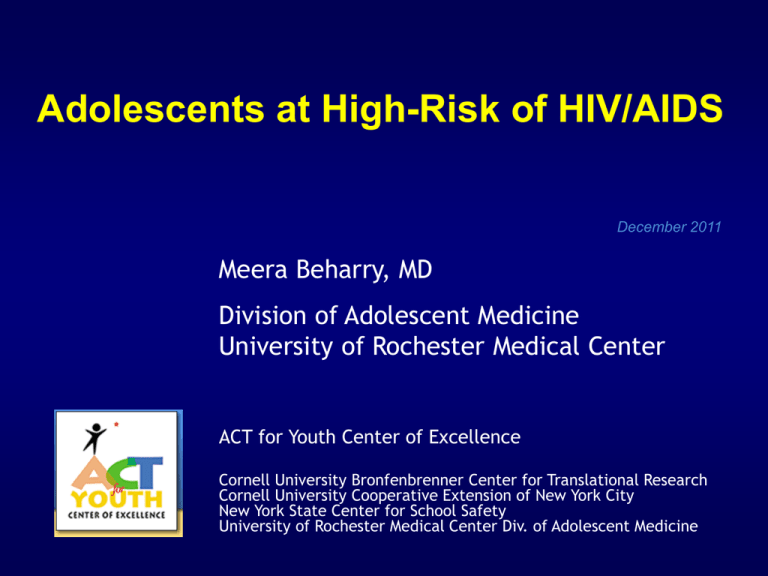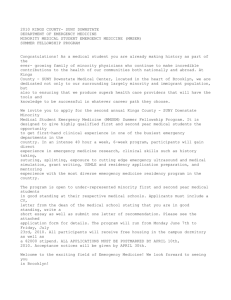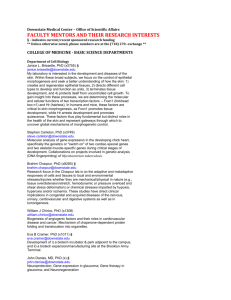
Adolescents at High-Risk of HIV/AIDS
December 2011
Meera Beharry, MD
Division of Adolescent Medicine
University of Rochester Medical Center
ACT for Youth Center of Excellence
Cornell University Bronfenbrenner Center for Translational Research
Cornell University Cooperative Extension of New York City
New York State Center for School Safety
University of Rochester Medical Center Div. of Adolescent Medicine
Objectives
Define high-risk youth populations
Discuss the additional challenges for this
population
Review strategies that work
Definition High Risk Youth
Unprotected sex (oral, anal, vaginal) with
multiple partners
Survival sex
Homeless youth
Men who have sex with men
LGBT
Sharing needles
Youth in justice system
Long term survivors of peri-natal HIV infection
Survivors of sexual abuse
CDC Vital Signs Dec. 2011
1.2 million people are
living with HIV
240,000 don’t know
they are infected
Only 28% of people
with HIV are taking HIV
medicine regularly and
have their virus under
control.
CDC Vital signs Dec. 2011
CDC Vital signs Dec. 2011
Imagine
Keys for success
Age appropriate
Developmentally appropriate
Culturally competent
Youth friendly, discrete and easily accessible
location
Convenience = “one-stop” full service clinic
Partnership with New York State
Multi-disciplinary team
Community involvement
Jeffrey M Birnbaum, MD,MPH
SUNY Downstate Medical Center
Members of Multidisciplinary team
Adolescent Medicine Medical ProvidersPhysician, PA or Nurse Practitioner
Nursing
Mental Health Providers- Psychologist,
Psychiatrist, Social Worker
Case Management
Outreach- Outreach Coordinators, Peer Educators
Research
Why do we need to have HIV related
services specifically for adolescents and
youth?
Definition High Risk Youth
Unprotected sex (oral, anal, vaginal) with
multiple partners
Survival sex
Homeless youth
Men who have sex with men
LGBT
Sharing needles
Youth in justice system
Long term survivors of peri-natal HIV infection
Survivors of sexual abuse
Special Needs of Young MSM/Gay Youth
with HIV
Disclosure of sexuality in general as well as
how it relates to engagement in care and
treatment adherence
Outreach to “ballroom” community and other
venues for MSM/gay male youth
Mental health issues: increased suicide rates,
social isolation, peer support
Clinical expertise in dealing with syphilis, anal
STDs
Jeffrey M Birnbaum, MD,MPH
SUNY Downstate Medical Center
What about youth infected with HIV
perinatally?
Unique Clinical Issues in Perinatally Infected
vs. Behaviorally Infected Youth
Perinatally infected youth more likely to be in
more advanced stages of HIV disease and
immunosuppression
More likely to have history of infections with
complications/disabilities (eg. blindness, O2
dependent, chronic renal failure)
More likely to have heavy ARV exposure hx
therefore more likely to have multi-drug
resistant virus
Jeffrey M Birnbaum, MD,MPH
SUNY Downstate Medical Center
Special needs of Adolescent /Young Adult
females with HIV
Sexual health related issues best dealt with
on-site in clinic if possible: routine gyn exams,
Pap smears, colposcopy, family planning
Expertise in dealing with teen pregnancy and
teen/young adult parenthood; HAART
adherence during pregnancy
Mental health issues: domestic violence,
power imbalance in relationships with older
men, hx of sexual abuse
Jeffrey M Birnbaum, MD,MPH
SUNY Downstate Medical Center
IDU
Special Needs of Transgender Youth
Issues related to consent for care
Mental health aspects of transgender care
Specific hormonal regimens
Interactions between hormonal treatments
and prevention counseling specific to this
population
Case management issues: gender identity
on Medicaid card, legal name changing,
housing, education, employment
Jeffrey M Birnbaum, MD,MPH
SUNY Downstate Medical Center
Risks of Hormonal Therapy NOT under a
Doctor’s Care
Untreated mental illness, young person may not
be a “true transgender”
Risk behaviors involved in being able to buy
hormones
Street hormones
“German hormone”, “pure hormone”, “silicon”
Needle sharing/”hormone parties”- Hep B, Hep C & HIV
Bacterial infection from non-sterile technique/supplies
Liver damage; blood clotting problems, deep vein
thrombosis
Prescribing doctor may not know about
transgender health.
Recommend: http://www.wpath.org/
SEX!!!
Future
Looking cool
FOOD!
Friends
FOOD! &
buying
stuff
Life Skills Needed for Transition to Adult
Clinic
Knowing when and how to seek medical care for
symptoms or emergencies
Using one’s primary care provider appropriately
Making, canceling, and rescheduling appointments
Coming to appointments on time
Calling ahead of time for urgent visits
Refilling of prescriptions on time
Maintenance of one’s health insurance
Negotiating multiple subspecialty providers
Jeffrey M Birnbaum, MD,MPH
SUNY Downstate Medical Center
Summary
High-risk youth need specialized care
Multi-disciplinary team
Age appropriate, developmentally appropriate
and culturally competent care
Call: 1-800-541-AIDS (English) 1-800-233-SIDA
(Español)
References
HEAT Program:
http://www.heatprogram.org/ask_general.html
CDC: www.cdc.gov/hiv/
NYS DOH AIDS Institute:
http://www.nyhealth.gov/diseases/aids/
100 questions and answers about HIV/AIDS
http://www.nyhealth.gov/publications/0213.pdf
http://www.nyhealth.gov/publications/0214.pdf
(Español)
NYC DOH/Mental Health:
www.nyc.gov/html/doh/html/ah/ah.shtml
ACT for Youth Center of Excellence
Was this presentation useful? Please give us your feedback:
http://www.zoomerang.com/Survey/WEB22AEZWMYJH3
The ACT for Youth Center of Excellence connects positive youth
development resources and research to practice in New York State and
beyond. The Center provides:
Technical support, training, and evaluation for youth-serving
programs funded by the NYS Department of Health.
Youth Development resources: www.actforyouth.net, publications,
training and events, and the e-letter ACT for Youth Update. Email
act4youth@cornell.edu to subscribe.
A home base for the ACT Youth Network. Visit the network at
www.nysyouth.net
act4youth@cornell.edu • 607-255-7736 • http://www.actforyouth.net








